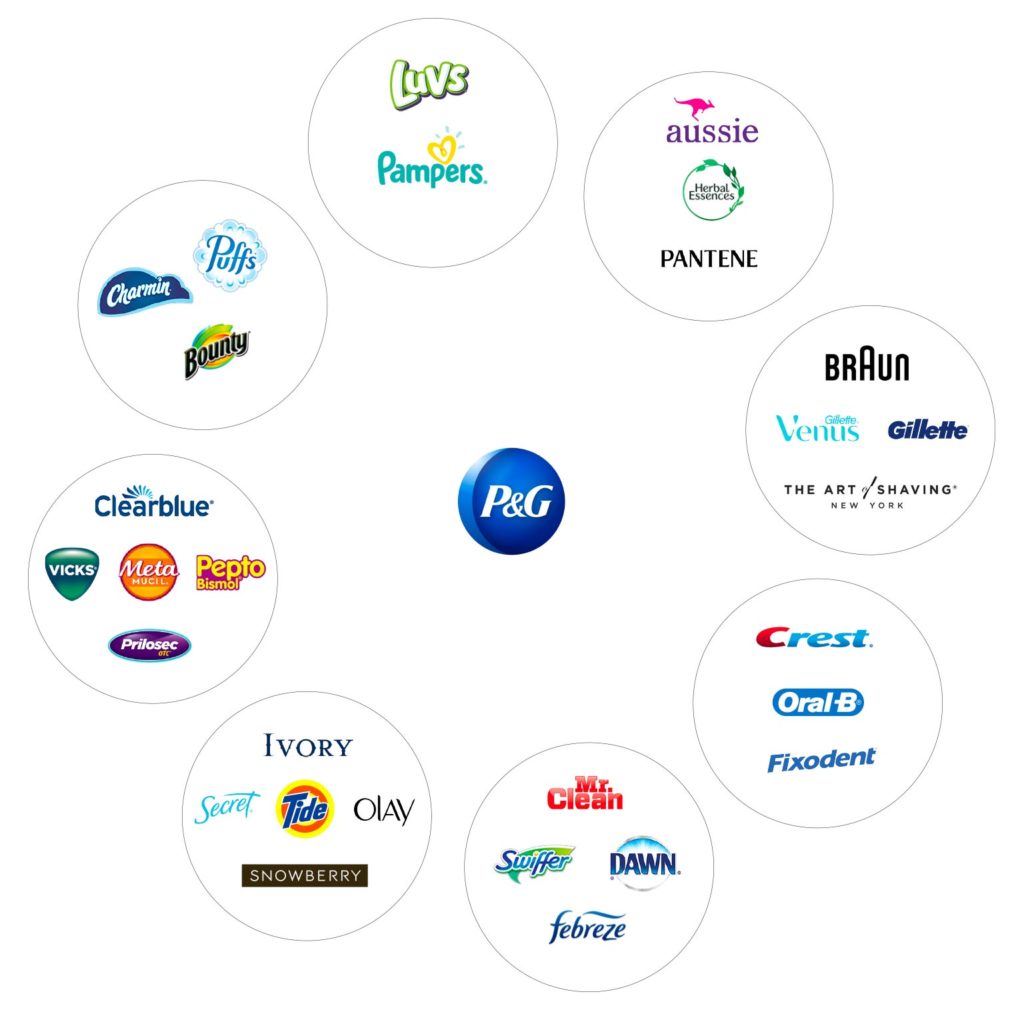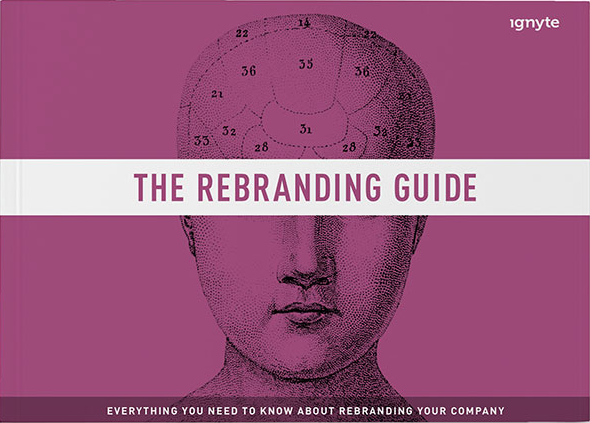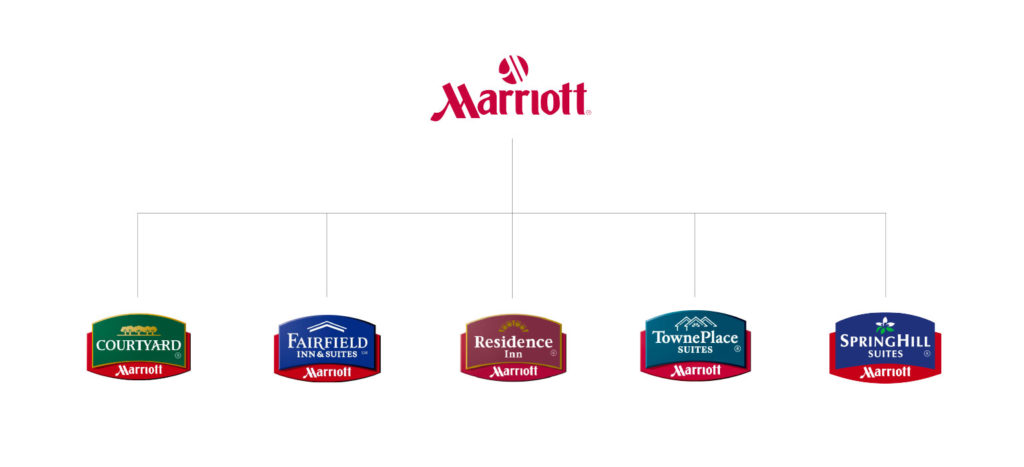Which Of The Following Is A Primary Factor Specific To Services In Choosing A Brand Name
Is your brand overly complicated, confusing, or just manifestly chaotic? A redesigned brand architecture might be in order.
An intuitive brand architecture is the best way to bring your business concern's range of offerings into focus, letting you meliorate cross-promote them and gain control over how your brand is perceived by consumers.
In this postal service, nosotros'll take a look at the types and benefits of brand architecture, likewise as provide a step-by-stride guide to creating a articulate brand architecture for your own brand:
CONTENTS
- What is Make Architecture?
- Types of Brand Architecture
- The Benefits of a Articulate Make Architecture
- How to a Create a Clear Brand Compages
- Factors to Consider When Creating a Brand Architecture
- The Takeaway
To fully sympathize what brand architecture tin can exercise for your company, let's start past unpacking brand architecture itself.
What is Brand Architecture?

Brand compages is the organizational construction of a company's portfolio of brands, sub-brands, products, and/or services.
Effective brand architecture includes an integrated organization of names, symbols, colors, and visual vocabulary informed directly by the consumer thought process.
This is considering key to make architecture is your customer'south mental organization—how they conceptualize your business organization and its portfolio of offerings, and how each offer satisfies their needs.
Brand compages defines both the breadth and depth of your brand.
Not simply does it provide clarity around the arrangement of your offerings and how they are understood by consumers, it also influences client beliefs by maximizing the transfer of brand equity between your brands and sub-brands.
If a client has an existing human relationship or positive clan with a master brand, for example, they are much more likely to endeavour 1 of its sub-brands.
Brand architecture is ultimately about managing perception.
Externally, information technology helps your customers and other stakeholders brand sense of a multifaceted system.
Internally, it tin serve as a valuable tool for optimizing marketing efficiency and performance. Only the benefits don't stop there.
Types of Brand Architecture
In its most mutual iterations, make architecture falls into one of 4 categories: branded house, house of brands, endorsed, or hybrid.
Permit'southward take a closer look:
Branded House

A branded house includes a strong main brand with divisions that characteristic the principal brand name aslope a product or service description. Examples include FedEx and its extensions FedEx Limited, FedEx Ground, FedEx Freight, etc.
The branded house compages capitalizes on established customer loyalty where audiences intendance less about production features or benefits than they do about the central brand promise they know and love (in the case of FedEx, "When it admittedly, positively has to be at that place overnight").
Additional benefits of the branded house approach include more efficient marketing and advertising spend and positive disinterestedness spillover betwixt sub-brands.
Of course, spillover can be negative equally well. A trouble with one sub-brand can wind up being a problem for the entire branded house.
Some other risk inherent to a branded house strategy is dilution: when a make is positioned also broadly across multiple service categories, its affect can get diffuse and ineffectual.
Examples of a branded business firm include:
- FedEx
- Apple
- John Deere
- Harley Davidson
- Virgin
House of Brands

A business firm of brands architecture features a drove of distinct, familiar brands nether a parent brand that customers may or may not be aware of. The parent brand is primarily important but to the investment community.
The brand extensions in a house of brands organisation substantially endorse each other, while the parent brand realizes the benefits. We find this in brands similar Proctor & Run a risk and its vast array of products across multiple industries.
Products within a business firm of brands architecture sometimes characteristic their parent brand's identity on their packaging by way of a pocket-sized logo or accost.
Some companies with a business firm of brands architecture cull not to broadcast the relationship between their parent make and portfolio brands because of specific strategies around pricing, perceived quality, or target audiences.
The benefits of a house of brands approach include the ability to achieve various audiences and markets with a collection of specialized value propositions.
As for the cons, the biggest problem with this type of make is budget. Each private make requires separate advert and marketing, and the opportunities for cantankerous-promotion are few.
Under a firm of brands, the parent brand operates like a belongings company for its various portfolio brands, managing each brand equally though it were a separate company. The necessary legal complexities of this strategy entail significantly greater costs as well.
Examples of a house of brands include:
- Newell
- Procter & Chance
- Unilever
- Nestle
- Full general Motors

The Definitive Guide to Rebranding
Everything you need to know about rebranding your business-and avoiding costly mistakes.
Endorsed

In an endorsed architecture, there is a parent brand and associated sibling brands, all of which have unique market presences. The sibling brands benefit from their association with, or endorsement from, the parent brand.
The relationships between the sibling brands within an endorsed compages is ofttimes mutually beneficial, as well, each benefitting from the forcefulness of the other.
Examples include Kellogg and Nabisco, both of which proudly feature the name of their parent brand on each of their products' packaging.
An endorsed strategy is ane where you'll discover messaging like "brought to you by…". Endorsement limits a business organization's reputation take a chance and offers more positioning alternatives than a house of brands arroyo, for example.
Examples of an endorsed brand architecture include:
- Nabisco
- Kellogg
- Ralph Lauren
- Caterpillar
- Honda
Hybrid

Finally, a hybrid make architecture comprises some combination of the above iterations.
In the instance of Alphabet, Google is immune to operate in the space it knows best, search and ad, while smaller brands, like Nest, Sidewalk Labs, and Calico operate as individual companies in their own specialized verticals.
A hybrid model offers the flexibility of having multiple tiers of distinct hierarchies, including varying levels of market place-facing brands subservient sub-brands.
Many companies that have adopted the hybrid strategy accept done so out of necessity, though. A hybrid architecture is often more of an advertizing-hoc arroyo borne from mergers and acquisitions, rather than a proactive make strategy.
Examples of a hybrid brand compages include:
- Alphabet
- Coca-Cola
- Microsoft
- Amazon
- Marriott Bonvoy
The Benefits of a Clear Make Compages

If you're unaware of the applied benefits of brand architecture, yous're non lonely.
We find that many business owners accept a express understanding of this important strategic device and the challenges it can accost.
What types of challenges? For starters:
- Your customers aren't aware of or don't fully understand your full list of your products and/or services
- Y'all have one or more production/service that vastly out-performs the others and you lot want to transfer some of its brand disinterestedness
- You have one or more than production/service that vastly under-performs your other offerings and you want to improve its visibility and/or reputation
- You've recently acquired or plan to acquire a new brand and want to ensure you go the most out of integrating its products/services
- You're launching a new product/service line and need to integrate it with your existing offerings
- Yous're preparing for a liquidation event and want to ensure you've maximized your company'southward make equity
The list of practical benefits doesn't stop there. A common misconception is that make compages is only for large, circuitous organizations. But even small businesses can see measurable improvements in operation past better organizing their offerings.
Regardless of your visitor's size, effective brand architecture can enable you to…
Target the needs of specific customer segments.
Brand architecture enables y'all to segment your messaging so that each of your target audiences hears what they want to hear and gets precisely what they're looking for.
Significantly reduce marketing costs.
When brands are architected in a logical, intuitive manner, your marketing efforts are exponentially more efficient. With opportunities for cross-promotion between brands, marketing is more effective too.
Analyze positioning and messaging.
Nix increases the efficacy of your brand positioning like clarity. Clearly articulating positioning and messaging is similar giving your brand a high-operation tune-up.
Facilitate growth and bolster stakeholder confidence.
The modular nature of an intuitive brand architecture makes it easier to add brands, products, or services every bit your visitor grows. And well-managed, time to come-minded brands are a reassuring sign for investors and employees alike.
Heighten customer awareness.
When a brand'south diverse divisions are not clearly delineated, they must rely on the parent brand to capture the attention of the marketplace. Brand compages gives a parent brand the power of diversification by highlighting the unique strengths of its singled-out sub-brands.
Build and protect brand equity.
The result of all of the benefits above is the ultimate competitive advantage for whatsoever company: brand equity. Growing your make equity gives you compound returns as manufacture authority and marketplace valuation grow with it.

The Definitive Guide to Rebranding
Everything you need to know about rebranding your business-and avoiding costly mistakes.
How to a Create Clear Brand Architecture

How practice yous create a brand architecture that benefits both your company and your customers? Firstly, don't over-complicate it. The purpose of brand architecture is to make your offerings clearer, not more convoluted.
There are 3 simple steps toward defining a sound, intuitive brand compages: Research, Strategy, and Migration.
i. Enquiry
The best make architecture starts with client research on brand awareness, brand loyalty, and associations. Only with research can y'all know how your audience understands (or doesn't understand) your fundamental offerings.
Research data will tell y'all which brand architecture blazon will best support your business concern strategy. Information technology gives yous the information you need to parse your offerings or divisions in a way that makes sense to those you serve.
Research includes qualitative initiatives like i-on-one interviews with internal and external stakeholders.
Quantitative enquiry enables you lot to test the hypotheses developed in the qualitative phase with more widely distributed online surveys to understand how and why your customers make decisions.
Other research types include make equity studies to amend sympathise the equity each of your business's brands has in relation to each other and the market at large.
And a competitive brand audit will provide farther insight into the strengths and weaknesses of your brands, as well as those of your top competitors.
two. Strategy
In the strategy stage, yous determine the optimal brand architecture type for your business's unique needs. Each type offers a different mode to leverage (or not leverage) the master brand.
How closely do you want to associate your sub-brands to your parent brand?
This question is particularly relevant if you've recently undergone a merger or acquisition (and fifty-fifty more relevant if a old competitor was involved in the procedure).
To what extent should your various brands cantankerous-reference and promote each other, or to what extent do they need to remain independent?
The all-time way to answer this question and others like information technology is to create illustrative examples of multiple architecture alternatives, identifying the pros and cons of each. Evaluate each alternative against pre-determined criteria to ensure objectivity.
Prioritize clarity in the connections betwixt sub-brands, divisions, products, or services.
Cross-promotion between brands doesn't piece of work if customers are dislocated past the correlations between your extensions. The more common elements there are amidst your brands, the stronger the synergy is between them.
Lastly, be realistic when it comes to budget and resource. Make sure to create a organisation that you tin reasonably expect to back up given the manpower and capital yous accept bachelor.
3. Migration
The final pace is to create a design for the organisation y'all've organized and outline a program for migration.
This includes a naming construction and identity system that clearly delineate your diverse sub-brands or extensions in a fashion that aligns with your overarching brand strategy.
The visual and exact breadcrumbs that result from a tightly constructed pattern are key to helping customers and other external stakeholders navigate your brand compages.
In addition to the brand architecture blueprint, deliverables of this final phase should include a profile of your make portfolio, outlining the post-obit:
- The strategic role of each brand
- The scopes of each brand (offers, geographies, customers)
- The identity relationships of each brand to the principal brand
- Various approaches to the expression of each make
Finally, management tools such as conclusion copse for futurity architecture decisions will ensure that you go along to become the most out of your called compages as your brand continues to abound.
Factors to Consider When Creating a Brand Compages

There are many factors to consider when deciding which brand architecture type best suits your business's unique needs. We've outlined vi of the most of import ones below.
By taking into consideration each of the following concerns, you tin can mitigate the risk that is inherent to any brand restructuring.
Make Equity
It's important to evaluate both the force and flexibility of the existing equity in each of your brands.
Practise you lot run a risk losing valuable brand disinterestedness by consolidating brands after a merger or acquisition? Can an existing brand'south equity reasonably be leveraged to promote some other?
Proctor & Take a chance can't exactly leverage the disinterestedness of its Head & Shoulders brand to promote other products in its portfolio like batteries or cold medicine. The resulting confusion would be problematic for all the brands involved.
Culture
Internal factors like values and company culture are simply equally important as external ones when structuring your brand compages.
If you've caused a new company with a radically different civilization, it's of import to ask whether it makes more than sense to merge it or keep it carve up.
Sure divisions operate amend with a level of autonomy that isn't compatible with a codependent marketing strategy.
A branded business firm approach demands that all entities be on the aforementioned folio when information technology comes to positioning and brand personality. If that doesn't seem likely, or even possible, another architecture type should be considered.
Growth Strategy
Growth strategy should be forepart of mind when determining brand architecture.
Does your concern model entail pending mergers, acquisitions, or alliances? Do you plan to expand your product or service lines in the nearly (or even distant) futurity?
Your brand compages should support and enable successful growth by providing strategic latitude for each brand.
The correct arroyo will allow y'all to identify underperforming brands and avoid the exposure that comes with a single-brand strategy.
Market
Perchance the virtually important cistron is the market or markets in which your visitor operates.
If your concern targets a single market, a branded house can boost brand awareness, optimize marketing spend and bolster reputation.
If you have products or services aimed at significantly different markets, multiple brands can aid to protect each marketplace from the other, mitigating gamble and ensuring differentiated messaging.
The Ritz Carlton retains its luxury status by keeping a branded distance from its parent company, Marriott, and other, more upkeep-conscious sub-brands in the Marriott family.
Unable to compete in the luxury machine market because of its businesslike paradigm, Toyota launched Lexus.
And by acquiring natural foods brand Odwalla, Coca-Cola gained admission to a fast-growing market place segment that was previously unavailable because of the soda behemothic'south association with junk nutrient.
Multiple brands mean multiple ways to fulfill the unique needs of multiple audiences.
Disruption
Another key factor is how much disruption you're willing to suffer with reorganized make compages.
Every rebranding initiative entails a certain amount of chance. The important affair is to mensurate that risk against the long-term gain y'all stand to realize.
Realigning lesser-known products under a well-known brand is relatively take a chance-complimentary. Rebranding well-known products with a new and unfamiliar parent brand run the hazard of confusing and/or alienating a brand-loyal client base.
Cost
Last merely certainly not least among factors to consider when creating your brand architecture is cost, particularly the cost of rebranding that a new brand architecture entails.
Maintaining a slew of separate brands is always going to be costlier than organizing all of your offerings under a unmarried make.
Information technology'southward also expensive to rebrand the packaging, signage, and digital assets of multiple brands and consolidate them under a new unmarried entity. Intangible costs like brand disinterestedness need to be considered as well.
The Takeaway
Building a solid make architecture isn't easy, which is why branding agencies exist.
Ultimately, it's about parsing the nuances of your make and, with the help of meticulous inquiry, deciding how to leverage each of its offerings to best benefit the whole.
By carefully considering each of the important factors listed in a higher place, you lot can mitigate the risk associated with any revised brand architecture.
Think, the goal of make architecture isn't but to come up up with clever names for your products and services. Information technology'southward to create clarity from chaos and sharpen the border of your ongoing branding efforts.

The Definitive Guide to Rebranding
Everything you need to know about rebranding your business organization-and avoiding costly mistakes.
Source: https://www.ignytebrands.com/brand-architecture-creating-clarity-from-chaos/
Posted by: rachalbeenarile.blogspot.com


0 Response to "Which Of The Following Is A Primary Factor Specific To Services In Choosing A Brand Name"
Post a Comment